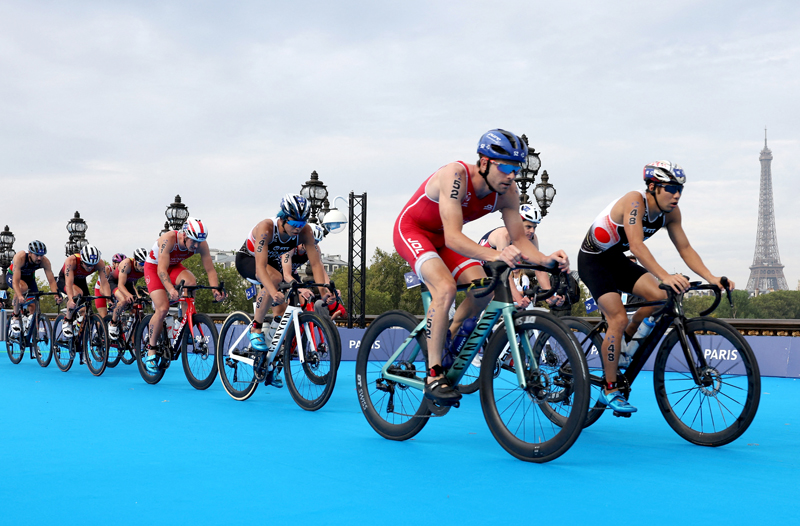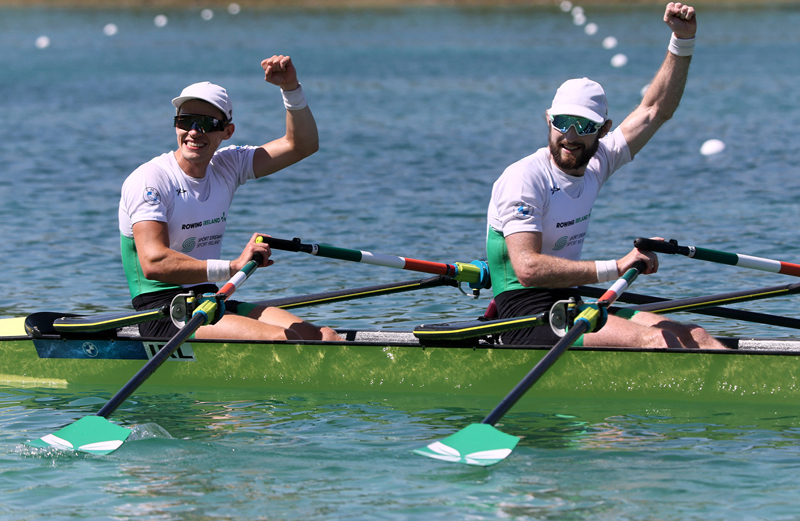Triathlon performance: the king of disciplines

The physiological demand of needing to excel in three different endurance sports to succeed in triathlon has always fascinated sports scientists. This explains why there have been a number of studies into what makes a good Ironman triathlete, and what characteristics in a given triathlete help predict a fast triathlon time. Some of these studies have focussed on the physical characteristics of successful triathletes while others have looked at how performances in each of the individual disciplines impact and predict overall performance.
Physical characteristics of good triathletes
One study compared the height, weight, and percent body fat data of accomplished Ironman triathletes with those of elite athletes from the sports of swimming, cycling, and running(1). It indicated that the physiques of these elite triathletes were most likely to be similar to that of elite cyclists – rather than elite distance runners (who tend to be lighter and smaller) or elite swimmers (who tend to be more powerfully built, especially in the upper body).
Other studies have shown that (for short-distance triathletes at least), elite triathletes are likely to be tall, of average to slightly lighter weight, and with low levels of body fat(2). Also, research suggests that body composition – specifically a low level of body fat - is important for an overall fast race time and fast split times in each of the three disciplines(3). Meanwhile, a 2015 Swiss study on Ironman and ultra-triathletes (up to double-Ironman length) found that faster performance times were predicted by low levels of body fat in both cases(4).
Training characteristics
Other studies have focussed more on the training characteristics of successful triathletes, and asked whether there are any common themes. In the Swiss study above, high levels of training volume predicted the best performances in ultra, whereas average speed during training predicted the best performing Ironman-length triathletes(4). In another study published the same year by the same team of scientists, the most important predictive variables for a fast Ironman race time were an age of 30-35 years, a fast personal best time in Olympic distance triathlon, a fast personal best time in a marathon, high volume and high speed in training (where high volume was more important than high speed) and low body fat(5).
Predicting performance
Related to both physical and training characteristics, some researchers have investigated whether it’s possible to use these in order to predict performance in a future triathlon event. In a previous SPB article, we investigated research on predicting completion times for triathletes taking on a full-length Ironman triathlon – a useful to get a handle on because the extraordinary length of an Ironman means that novice Ironman competitors will almost certainly be entering new and unknown territory where they’ll encounter new levels of muscular fatigue, severe nutritional challenges and the possibility of cramps, blisters, dehydration etc.
In a nutshell, this research indicated that physical characteristics were not good predictors of performance. Instead, the triathletes’ marathon and Olympic distance triathlon personal best times were most strongly related to their Ironman race time. In addition, the average speed when running during training was also related to overall performance, albeit less strongly. In fact statistical analysis indicated that these three variables alone explained 64% of the actual Ironman race times. Somewhat surprisingly, the triathletes’ previous performances at Ironman distance were not a good prediction of Ironman performance. Also, the volume of cycling training carried out seemed to be a poor predictor of performance – surprising because in terms of time expended, the cycling portion of an Ironman triathlon is the most substantial (you might imagine that the ability to spend long times in the saddle without becoming unduly fatigued would be a key factor for performance).
Yet another study on 53 recreational female triathletes found that the strongest performance predictors of Ironman performance were not related to cycling hours accumulated during training but instead their previous personal best times for the marathon and Olympic distance triathlon. Indeed, when the data was statistically analyzed for numerical relationships between these parameters, the researchers were able to produce a formula to approximately predict Ironman race times (all times in minutes): Ironman time prediction (in minutes) = 186.3 + 1.595 × (PB for Olympic distance triathlon) + 1.318 × (PB for marathon).
The split approach to prediction
How important is cycling for predicting and producing good triathlon performances? Given that a fast marathon performance seems to be a strong predictor of a good Ironman time and also that cycling volumes accumulated during training don’t seem to be correlated to good performances (at least for the Ironman distance), you might assume that the cycling discipline is somewhat less important in predictive power than running. However, when you look at a range of triathlon distances and consider pacing – specifically the split times for each segment of the race – the element of cycling begins to look much more important.
According to research on race pacing during triathlon events, split times are important for predicting performance, with the predictive power of each split discipline varying depending on the length of the race(6). Studies have found that in sprint distance and Ironman events, the cycling split times are the most predictive of overall race performance(7,8). In contrast, for Olympic distance triathlons, fast (but not very fast – see later) splits seem to be the most powerful predictor of fast race times(9).
When it comes to other triathlon distances, less is known about predictors of performance. This is especially the case with the half-distance Ironman triathlon (also known as ‘Ironman 70.3’), which involves a 1.9km swim, 90km cycle, and 21.1km run. Half-Ironman events have been gaining in popularity in recent years, as evidenced by an increase in both the number of races and competitors(10). This surge in interest has prompted a rise in scientific research focused on the half-Ironman distance.
To date, only one study has analyzed this distance in terms of the predictive power of split times(11). It found the cycling split to be the most important factor in predicting overall race times. However, while this study was pretty comprehensive, looking at data from over 8,000 professional triathletes who competed between 2015 and 2020, the sample size was considered below optimum for drawing really concrete conclusions about split times and predictive power at this distance. What is really needed to be confident is a larger study with a greater number of athletes and race results.
New research
To try and obtain a definitive answer on the importance of cycling split times for predicting triathlon race performance, an international team of researchers has published new research on this topic(12). Published in the journal ‘Frontiers in Sport and Active Living, this study has analyzed 16,611 records of professional triathletes who participated in 787 half-Ironman races, spanning the years 2004 to 2020.
Data was collected only from professional triathletes (those registered with www.ironman.com/pro-athletes) who had raced in officially certified half-Ironman race. To ensure an accurate data set, records were excluded if any of the following applied:
· Athletes did not start or finish the race
· Athletes were disqualified at any point in the race
· Athletes were missing one or more split time
· Any records that were numerically inconsistent – eg impossible split times or final times that were faster than split times, etc.
The relationship between the athletes’ split times for each discipline and their overall finish time was then analyzed using a statistical technique known as ‘multiple linear regression’ (MLR for short).
What they found
The key finding was that out of the three disciplines, it was the bike times that were most closely correlated with overall finish times – a correlation score of 0.85 where a score of 1.0 represents perfect correlation and a score of 0 represents absolutely no correlation. This correlation score was the same for both male and female triathletes. In plain English, triathletes who clocked up a fast bike time were most likely to finish with a fast overall race time (see figures 1-3). Therefore, the ability to turn out a fast bike leg (rather than a swim or run leg) proved to be the most important predictor of a fast overall race time.
Run times were quite well correlated but less so that bike times. Interestingly, the run time correlation was poorer for women than for men (0.82 for the men and 0.75 for the women), meaning that predicting an overall race time from a run leg is less reliable when applied to female triathletes. Swim times meanwhile were poorly correlated with overall race performance, especially so for the women (0.63 for the men and 0.46 for the women). This indicates that trying to predict overall race performance in a half-Ironman by using your swim time is a poor method, especially for female triathletes!
Figures 1-3: Relationship between swim, bike and run leg times, and overall race times
You need to be logged in to continue reading.
Please register for limited access or take a 30-day risk-free trial of Sports Performance Bulletin to experience the full benefits of a subscription. TAKE A RISK-FREE TRIAL
TAKE A RISK-FREE TRIAL
Newsletter Sign Up
Testimonials
Dr. Alexandra Fandetti-Robin, Back & Body Chiropractic
Elspeth Cowell MSCh DpodM SRCh HCPC reg
William Hunter, Nuffield Health
Newsletter Sign Up
Coaches Testimonials
Dr. Alexandra Fandetti-Robin, Back & Body Chiropractic
Elspeth Cowell MSCh DpodM SRCh HCPC reg
William Hunter, Nuffield Health
Keep up with latest sports science research and apply it to maximize performance
Today you have the chance to join a group of athletes, and sports coaches/trainers who all have something special in common...
They use the latest research to improve performance for themselves and their clients - both athletes and sports teams - with help from global specialists in the fields of sports science, sports medicine and sports psychology.
They do this by reading Sports Performance Bulletin, an easy-to-digest but serious-minded journal dedicated to high performance sports. SPB offers a wealth of information and insight into the latest research, in an easily-accessible and understood format, along with a wealth of practical recommendations.
*includes 3 coaching manuals
Get Inspired
All the latest techniques and approaches
Sports Performance Bulletin helps dedicated endurance athletes improve their performance. Sense-checking the latest sports science research, and sourcing evidence and case studies to support findings, Sports Performance Bulletin turns proven insights into easily digestible practical advice. Supporting athletes, coaches and professionals who wish to ensure their guidance and programmes are kept right up to date and based on credible science.









